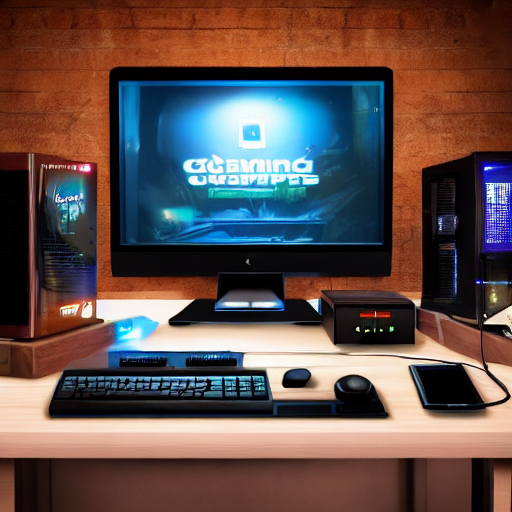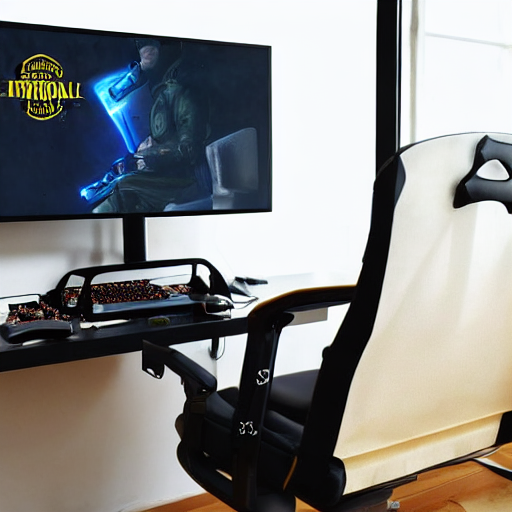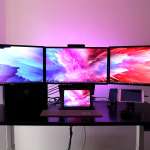Introduction to our buyers’ guide for a gaming monitor
Our buyer’s guide for a gaming monitor will help you select the perfect display for your gaming needs. We’ll cover everything from refresh rates to response times and explain what each specification means for gaming. With our guide, you’ll be able to find the perfect monitor for your gaming rig.
We will take a look at what you need regarding the settings and specs that will take you from a good gaming monitor to a great one. We know how easy it is to get lost in the aspect ratio, which could hurt the frame rate on the ultrawide monitor of your dreams. But honestly, there are so many different things at play that we will look directly at the important ones.
If you want to skip all this and just read what we think are the top 5 gaming monitors around, click right there. We take into consideration features, specs, quality, brand, user experiences/ reviews, as well as cost. We don’t just say buy a $10,000 monitor as its the best, we want to find the best value.
Gaming monitors: Which features matter?
There are many features to consider when choosing a gaming monitor. The most important factor is probably the resolution, as this will determine how clear and detailed the image on the screen is. Other important factors include the refresh rate, which determines how often the image on the screen is updated, and the response time, which determines how quickly the monitor can display changes in the image. Additionally, some gamers may prefer monitors with special features such as built-in speakers or USB ports.

What resolution do I need for gaming?
The answer to this question depends on what type of gaming you want to do. For example, if you want to play console games, you will need a different resolution than if you want to play PC games. Generally speaking, however, you will need a resolution of at least 1080p for gaming newer generation games. They are meant to be viewed in high def, and you don’t want to spend all that money on a game for it to look dreary and pixelated.
What should my gaming monitor’s refresh rate and response time be?
The refresh rate is the number of times the image on your screen is refreshed per second. The response time is the amount of time it takes for a pixel to go from being fully “on” to fully “off” or vice versa. A higher refresh rate and lower response time are both better for gaming. For example, a 60 Hz refresh rate means that the image on your screen is refreshed 60 times per second, while a 1 ms response time means that it takes 1 millisecond for a pixel to change from one color to another.
What Size Should a Gaming Monitor Be?
The size of a gaming monitor is an important consideration for gamers. A larger monitor can provide a better gaming experience, allowing for a more immersive experience. However, a larger monitor can also be more expensive and may take up more space. Ultimately, deciding what size gaming monitor to purchase depends on the individual’s needs and budget.
How Much Should a Gaming Monitor Cost?
This is a difficult question to answer, as many factors must be considered. The size of the monitor, the resolution of the monitor, the refresh rate, and the features all play a role in determining the price. In general, you can expect to pay anywhere from $100 to $1000 for a gaming monitor. We aren’t saying that you need to break the bank when it comes to a monitor, as there are some great values out there for sure.
But the higher the price tag, you will get some features people might need. If you do a lot of design work or are a professional gamer, maybe an expensive monitor is right for you. At the end of the day, you decide how you’ll be using it and what you feel the monitor is worth to you.
How Important Are Refresh Rate and Response Time?
Refresh rate and response time are important factors to consider when choosing a monitor. A higher refresh rate means that the image on the screen will be refreshed more often, resulting in a smoother image. A lower response time means there will be less lag between when you input a command and when it is displayed on the screen.

What Inputs Does a Gaming Monitor Need?
A gaming monitor needs a few specific inputs to work properly. Firstly, it needs an HDMI input in order to receive the video signal from the gaming console or PC. Secondly, it needs a power input to be able to power on and operate. Lastly, it may also need additional inputs for things like audio or USB, depending on the specific model and features.
What’s the Best Panel For a Gaming Monitor?
There are a few things you need to consider when it comes to gaming monitors. The first is what kind of panel you want. There are three main types of panels out there: TN, IPS, and VA. Each has its own benefits and drawbacks that you need to consider before purchasing.
TN panels are the most popular choice for gamers. They offer fast response times and high refresh rates, which is perfect for fast-paced games. However, they often have poorer color accuracy and viewing angles than other types of panels.
IPS panels offer better color reproduction and wider viewing angles than TN panels. However, they typically have slower response times, which can be a problem for gamers who need every advantage they can get.
VA panels are a good compromise between TN and IPS panels.
4K, 1440p, 1080p or…?
It seems like every day, there’s a new resolution or gaming monitor on the market. So which one should you buy? It all depends on what you want to use it for. Here’s a quick guide to help you decide.
4K monitors are great for gamers who want the highest level of detail and image quality. However, they can be expensive and require powerful graphics cards to run properly. 1440p monitors offer a happy middle ground between 1080p and 4K, providing excellent image quality without the high price tag. 1080p monitors are the most common and most affordable option, perfect for budget-conscious gamers. We have done a full breakdown of the different resolutions and what they mean for monitors, so to keep this guideline article shorter, we suggest you go look at that article… as it can get very long very fast.
One thing to remember is that if your source doesn’t match the output, you will not get the desired results. What we mean is that if you have a monitor with a high resolution, but the output is 480p, you would be enjoying any 4k gaming. This in turn, will leave your new monitor falling low below your expectations.
This is no different than with TV sets. Your picture won’t look good if you have a huge screen size, but the resolution is low. For everything to work right, you need high-quality input and the ability to display that input.
So although 2560 x 1440 might sound like the goal, the reality is that it is useless if you don’t have the feed for that resolution.
Curved or Flat Monitor for Gaming?
There is no definitive answer when it comes to choosing between a curved or flat monitor for gaming. Ultimately, it comes down to personal preference and what you feel most comfortable. Some gamers prefer the added immersion that a curved monitor can provide, while others find that a flat screen is easier on the eyes. There are pros and cons to both options, so it really comes down to what you value most in your gaming experience.
In our testing, we never honestly found the curved monitors to be worth it. It might look great when you are directly in front of the monitor, but the field of view isn’t very good. You can’t move to the side, and the monitor may just distort everything to the point that it isn’t worth the cost. We find that the computer monitor works best when you don’t have to be totally still and 100% in front of it because sometimes you move or stand up etc., and that’s the whole point of having wireless peripherals, right?
Before Choosing A Monitor, Make Sure You Consider What Graphics Card You Have
Before you purchase a computer monitor, it is important to consider what type of graphics card you have. Different types of graphics cards are better suited for different types of monitors. For example, if you have a high-end graphics card, you may want to purchase a 4K monitor. However, if you have a lower-end graphics card, a 1080p monitor may be a better option. Additionally, it is important to consider the monitor’s refresh rate and response time before making a purchase.
Our thoughts on monitors
As technology advances, the way we game is changing. With new generations of consoles come new ways to play. However, one thing that has stayed relatively the same is the use of panels and gaming monitors. It is hard to even know what to look for in a gaming monitor, let alone what the best one on the market today is.
Monitors and panels have been integral to the gaming experience for years. They provide the player with visual information about their surroundings and enemies. Without them, gaming would be a very different experience.
There are different types of panels and monitors available on the market today. Each has its own advantages and disadvantages. It is important to choose the right one for your needs in order to get the most out of your gaming experience.
With so many options available, it can be difficult to know which panel or monitor is right for you. However, by doing your research and knowing what you need, you can find the perfect option for your gaming setup.
Conclusion of our article about the things to look for in a gaming monitor
After testing and reviewing dozens of gaming monitors, we’ve come to the conclusion that there are a few key things to look for when shopping for the perfect display for your gaming needs. First and foremost, you’ll want to make sure the monitor has a fast refresh rate and low input lag. You’ll also want to consider the panel type, resolution, and size of the monitor. And last but not least, make sure the monitor has all the extra features you need, like G-Sync or FreeSync support, HDR compatibility, and more. If you follow these guidelines and look for these features we know you will find a monitor that is best for you and your needs without breaking the bank.




